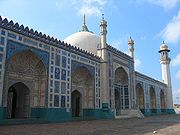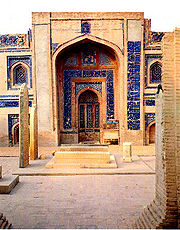
Mosques of Multan
Encyclopedia
Multan, Pakistan
has some of the oldest mosques, which were once considered as the jewels of the city. These mosques now remind us of the glorious past of Multan, which was governed by Muslims for more than a thousand years. Among the more famous ones are:
 This grand mosque of Multan is located on the main Multan-Lahore highway in the Northeast of the city. It was built in 1735 AD by Nawab Abdul Samad Khan when he was the governor of Multan. It is very spacious, provided with a vast courtyard and a huge prayer chamber measuring 250 feet by 54 feet and crowned by seven domes. Its exterior was faced with glazed blue tiles and the interior was ornamented with colorful mosaics. After independence it was found insufficient to accommodate the increased number of people so its courtyard was enlarged further.
This grand mosque of Multan is located on the main Multan-Lahore highway in the Northeast of the city. It was built in 1735 AD by Nawab Abdul Samad Khan when he was the governor of Multan. It is very spacious, provided with a vast courtyard and a huge prayer chamber measuring 250 feet by 54 feet and crowned by seven domes. Its exterior was faced with glazed blue tiles and the interior was ornamented with colorful mosaics. After independence it was found insufficient to accommodate the increased number of people so its courtyard was enlarged further.
 Sawi mosque is supposed to be one of the oldest mosques, which still exists though it has no roof now and most of its decorations have been damaged; glazed blue tiles were profusely used for ornamentation. Parts are still intact.
Sawi mosque is supposed to be one of the oldest mosques, which still exists though it has no roof now and most of its decorations have been damaged; glazed blue tiles were profusely used for ornamentation. Parts are still intact.
in 1757 (1171 A.H.) when he was the governor of Multan under Ahmad Shah Durrani
. The mosque is provided with a reservoir for the ablutions, baths, and a large hall for prayers. During the Sikh period, the gateway of the Mosque was used as the courthouse of the Nazim, while its great hall was utilized for keeping the Granth, or the holy book of the Sikhs. The Mosque was restored to the Muslims by the British Government at the commencement of the British rule.
Multan
Multan , is a city in the Punjab Province of Pakistan and capital of Multan District. It is located in the southern part of the province on the east bank of the Chenab River, more or less in the geographic centre of the country and about from Islamabad, from Lahore and from Karachi...
has some of the oldest mosques, which were once considered as the jewels of the city. These mosques now remind us of the glorious past of Multan, which was governed by Muslims for more than a thousand years. Among the more famous ones are:
Masjid Khaliq Wali
The first mosque built in Multan, constructed with carved bricks, located on old matital road. Ruins of this mosque are still visible.Jamia Mosque
The first mosque built in Multan was the Jamia Mosque, which was constructed on the orders of Mohammad Bin Qasim. Ruins of this mosque were visible till 1954 at Qasim Bella, but were washed away by the repeated floods of the river Chenab.Eid Gah Mosque

Sawi Mosque

Ali Muhammad Khan Masjid
Another old masjid of Multan, which is still in good condition, is Masjid Ali Muhammad Khan, which is also known as Mosque Wali Muhammad Khan. It is an excellent building, situated in the busiest Chowk Bazaar of the city. It was built by Nawab Ali Mohammad Khan KhakwaniNawab Ali Mohammad Khan Khakwani
Nawab Ali Mohammad Khan belonged to the Mohsin zai clan of the Khogiani tribe. He was given the title of Nawab by Ahmad Shah Durrani because with his help Multan became the part of Durrani Empire. He was appointed as the governor of Multan for his services...
in 1757 (1171 A.H.) when he was the governor of Multan under Ahmad Shah Durrani
Ahmad Shah Durrani
Ahmad Shah Durrani , also known as Ahmad Shāh Abdālī and born as Ahmad Khān, was the founder of the Durrani Empire in 1747 and is regarded by many to be the founder of the modern state of Afghanistan.Ahmad Khan enlisted as a young soldier in the military of the Afsharid kingdom and quickly rose...
. The mosque is provided with a reservoir for the ablutions, baths, and a large hall for prayers. During the Sikh period, the gateway of the Mosque was used as the courthouse of the Nazim, while its great hall was utilized for keeping the Granth, or the holy book of the Sikhs. The Mosque was restored to the Muslims by the British Government at the commencement of the British rule.

